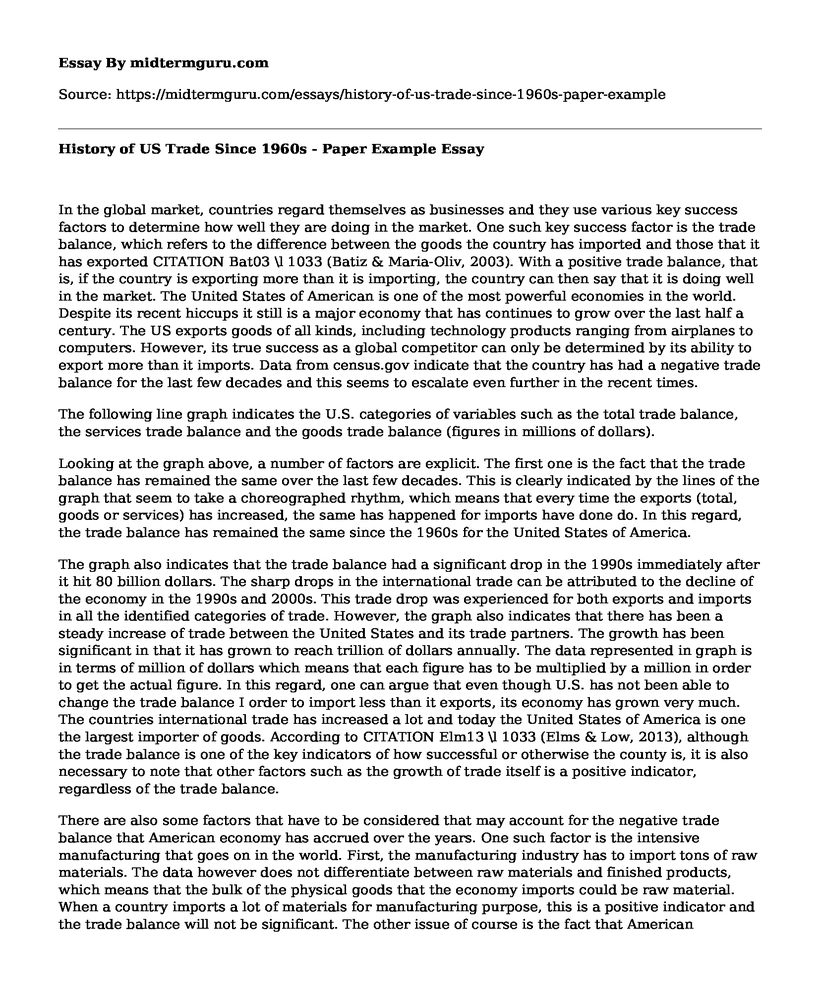In the global market, countries regard themselves as businesses and they use various key success factors to determine how well they are doing in the market. One such key success factor is the trade balance, which refers to the difference between the goods the country has imported and those that it has exported CITATION Bat03 \l 1033 (Batiz & Maria-Oliv, 2003). With a positive trade balance, that is, if the country is exporting more than it is importing, the country can then say that it is doing well in the market. The United States of American is one of the most powerful economies in the world. Despite its recent hiccups it still is a major economy that has continues to grow over the last half a century. The US exports goods of all kinds, including technology products ranging from airplanes to computers. However, its true success as a global competitor can only be determined by its ability to export more than it imports. Data from census.gov indicate that the country has had a negative trade balance for the last few decades and this seems to escalate even further in the recent times.
The following line graph indicates the U.S. categories of variables such as the total trade balance, the services trade balance and the goods trade balance (figures in millions of dollars).
Looking at the graph above, a number of factors are explicit. The first one is the fact that the trade balance has remained the same over the last few decades. This is clearly indicated by the lines of the graph that seem to take a choreographed rhythm, which means that every time the exports (total, goods or services) has increased, the same has happened for imports have done do. In this regard, the trade balance has remained the same since the 1960s for the United States of America.
The graph also indicates that the trade balance had a significant drop in the 1990s immediately after it hit 80 billion dollars. The sharp drops in the international trade can be attributed to the decline of the economy in the 1990s and 2000s. This trade drop was experienced for both exports and imports in all the identified categories of trade. However, the graph also indicates that there has been a steady increase of trade between the United States and its trade partners. The growth has been significant in that it has grown to reach trillion of dollars annually. The data represented in graph is in terms of million of dollars which means that each figure has to be multiplied by a million in order to get the actual figure. In this regard, one can argue that even though U.S. has not been able to change the trade balance I order to import less than it exports, its economy has grown very much. The countries international trade has increased a lot and today the United States of America is one the largest importer of goods. According to CITATION Elm13 \l 1033 (Elms & Low, 2013), although the trade balance is one of the key indicators of how successful or otherwise the county is, it is also necessary to note that other factors such as the growth of trade itself is a positive indicator, regardless of the trade balance.
There are also some factors that have to be considered that may account for the negative trade balance that American economy has accrued over the years. One such factor is the intensive manufacturing that goes on in the world. First, the manufacturing industry has to import tons of raw materials. The data however does not differentiate between raw materials and finished products, which means that the bulk of the physical goods that the economy imports could be raw material. When a country imports a lot of materials for manufacturing purpose, this is a positive indicator and the trade balance will not be significant. The other issue of course is the fact that American businesses have outsourced most of their production to other countries. When local firms move out to other countries, it becomes difficult for the country to account for the trade balance. Such firms will manufacture and sell their products in the countries where they have moved their manufacturing process and those goods will not be counted as exported goods from the local economy. The recent times especially in the 1990s saw a lot of American firms moving to other countries such as China, Indian and Brazil. This may help to account for the sharp drop in the graph that indicates that there was a major decline in international trade between the United States of America and the rest of the world. As a result, to get a clearer picture of the data, one would have to adjust for these factors such as the moving of American firms to other countries and also the differentiation between imports of finished goods and raw materials. Overall, however, the graph indicates that the United States foreign trade has continued to grow steadily and significantly, but with a negative trade balance.
References
Batiz, L., & Maria-Oliv, M. (2003). International Trade: Theory, Strategies, and Evidence. LOndon, UK: Oxford University Press.
Elms, D., & Low, P. (2013). Global Value Chains in a Changing World. Washington, DC: World Trade Organization.
Cite this page
History of US Trade Since 1960s - Paper Example. (2021, Jun 07). Retrieved from https://midtermguru.com/essays/history-of-us-trade-since-1960s-paper-example
If you are the original author of this essay and no longer wish to have it published on the midtermguru.com website, please click below to request its removal:
- Transnational Corporations Sales and Acorporate Social Responsibilities
- Comparison of Gross Domestic Product - Economics Paper Example
- Essay on International Business and Chinese World Trade
- Paper Example on International Trade and Environment: Malaysia Case Study
- Research Paper on United States-China Trade War
- Paper Example on Understanding China
- US vs China: Protectionism vs Free Trade - Essay Sample







